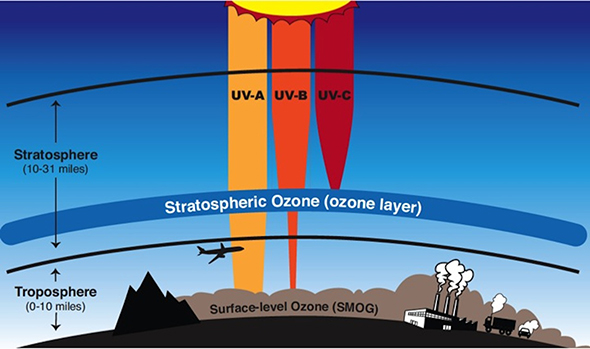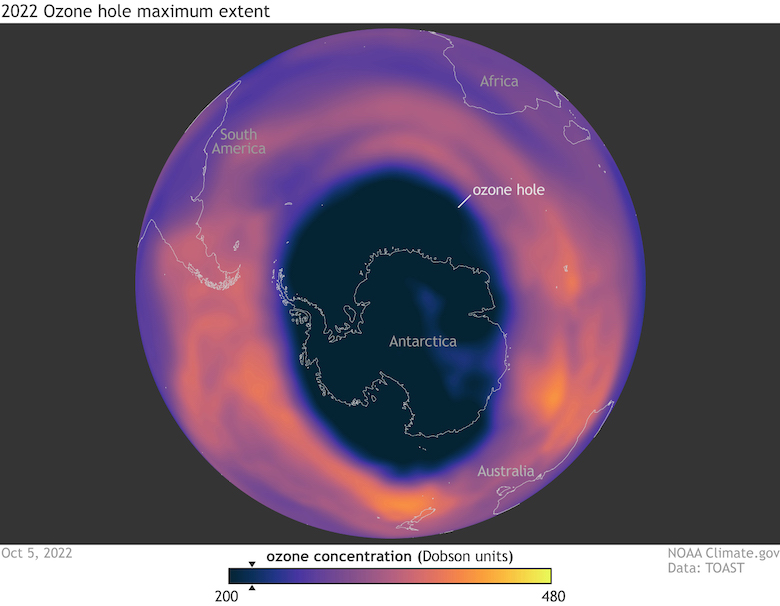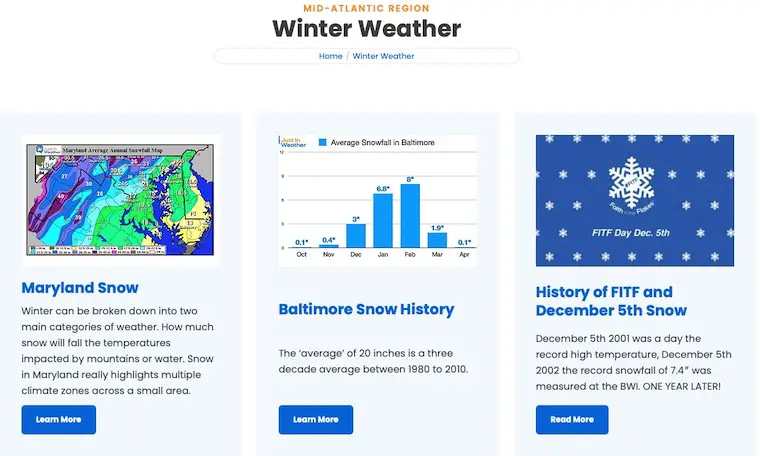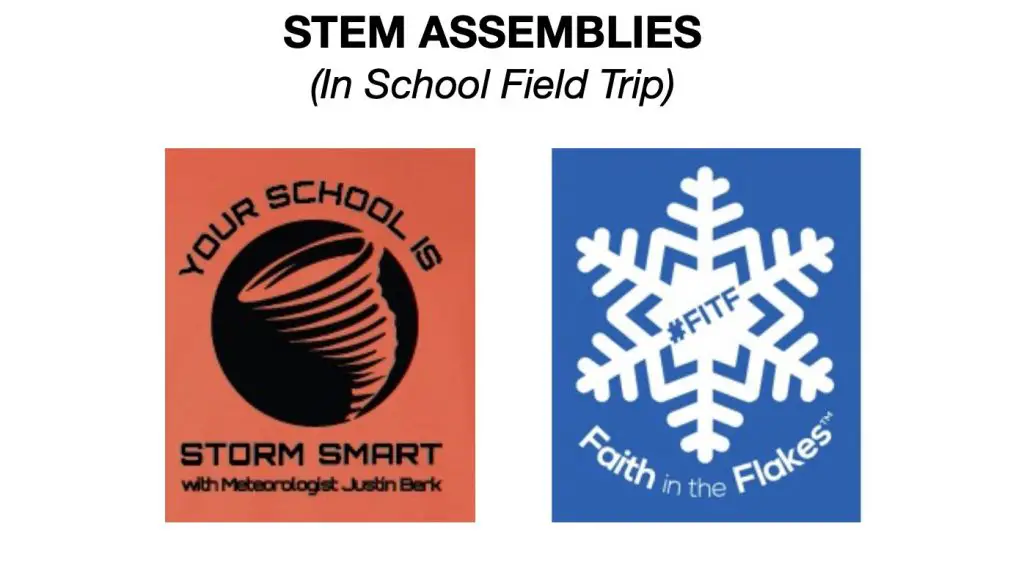NOAA and NASA Report Ozone Hole Over Antarctic Getting A Little Smaller And Improving
October 26 2022
Ozone is a form of oxygen that shows up in our atmosphere. Instead of two atoms bound together, which is the form we breath, this is three atoms that bind under certain circumstances. The contradiction is that it is toxic for us to inhale, but is vital to protecting life on Earth.
The toxic form of ozone is a form of pollution that occurs more commonly in the summer when pollution interacts with high angle sunlight and high temperatures. This is also one component of smog. This is why we have ‘Ozone Action Days’ sometimes during a heat wave.
The essential form of ozone is much higher in the sky in the stratosphere. This is above the weather portion of our sky and above the normal flight path of commercial planes between 10 and about 30 miles above the ground.
This is a more natural location for that molecule, where it serves to block harmful ultraviolet radiation from the sun. Without it, most life on our planet could not exist. So basically, we need this.

The hole in the ozone layer is actually a naturally occurring annual cycle, especially over the Antarctic where extremes of sun and darkness are met with a closed circulation aided by oceans surrounding the ‘bottom of the globe’.
In 1987, The Montreal Protocol was an international agreement banning the production of Chlorofluorocarbons (CFCs). These are refrigerants that were used air conditioners, but also shown to traverse the globe and break down the ‘good’ ozone facilitation the expanding Ozone Hole. It was phased out in the US in 1995, however CFCs can last in the atmosphere between 44 and 140 years.
Recovering Ozone Layer?
Monitoring the Ozone Hole fluctuation has been a major environmental priority, and it appears this past year brings some good news, shrinking about 10% in 2022.
From NOAA:
The hole over Antarctica had an average area of 8.91 million square miles (23.1 million square kilometers). That measurement is slightly smaller than the extent of 8.99 million square miles (23.3 million square kilometers) reached last year, and well below the average seen in 2006 when the hole size peaked.
Here, a NOAA ozonesonde — an instrument used to help scientists monitor the Antarctic ozone hole — ascends over the South Pole in this time-lapse photo taken October 21, 2020. (Courtesy of Yuya Makino/IceCube)

“Over time, steady progress is being made and the hole is getting smaller,” said Paul Newman, chief scientist for Earth Sciences at NASA’s Goddard Space Flight Center. “We see some wavering as weather changes and other factors make the numbers wiggle slightly from day to day and week to week. But overall, we see it decreasing through the last two decades. Eliminating ozone-depleting substances through the Montreal Protocol is shrinking the hole.”
The ozone hole happens when the protective ozone layer in the stratosphere above the South Pole begins to thin every September. Chlorine and bromine derived from human-produced compounds are released from reactions on high-altitude polar clouds. The chemical reactions then begin to deplete the ozone layer as the sun rises at the end of the winter in the Southern Hemisphere, with the strongest depletion occurring above Antarctica.
Different methods of measurement
NOAA and NASA researchers detect and measure the growth and breakup of the ozone hole with satellite instruments aboard Aura, Suomi-NPP and NOAA-20 satellites. This year, satellite observations determined the ozone hole area reached a single-day maximum of 10.2 million square miles (26.4 million square kilometers) on October 5, but is now shrinking.
NOAA scientists at the South Pole Station also record the ozone layer’s thickness by releasing weather balloons carrying ozone-measuring instruments called ozonesondes that measure the varying ozone concentrations, measured in Dobson Units, as the balloon rises into the stratosphere.
The lowest column amount detected by ozonesondes at the South Pole this year was 101 Dobson Units on October 3, according to Bryan Johnson from NOAA’s Global Monitoring Laboratory. This is very similar to last year’s measurements. At altitudes between 8 and 13 miles above Earth’s surface (14 to 21 kilometers), the ozone was almost completely depleted during the ozone hole’s maximum.
The ozone layer provides powerful protection against the sun’s ultraviolet rays, but is startlingly thin relative to the Earth’s crust and ocean, or even its total overhead atmosphere. In many places, the global average is about 300 Dobson Units, which if brought down to sea level pressure, is about as thick as two stacked pennies. Over Antarctica, the depleted ozone layer is roughly equivalent to the thickness of a dime.

Image Above: Satellite observations determined the ozone hole reached its annual maximum area of 10.2 million square miles (26.4 million square kilometers) on October 5, 2022. The lowest column amount detected by ozonesondes at the South Pole this year was 101 Dobson Units on October 3.
Factors affecting this year’s ozone hole
Measurements made via satellite and ozonesondes show that the Antarctic ozone hole has been smaller in recent years than it was in the late 1990s and early 2000s. This is due to the Montreal Protocol, a treaty adopted 35 years ago to ban the release of harmful ozone-depleting chemicals called chlorofluorocarbons, or CFCs. It remains the only international treaty ratified by every country on Earth. Amendments have helped it evolve over time to meet new scientific, technical and economic developments and challenges.
Scientists were also concerned about potential stratospheric impacts of the Hunga Tonga-Hunga Ha’apai volcano eruption on January 15, 2022, but so far, no direct impacts on the ozone layer have been noted in the data.
Learn more about NOAA’s Antarctic ozone research.
Weather posts straight to your inbox
Sign up and be the first to know!
Explore More Recent Climate Stories
Earth’s Warming Hole: Not Abrupt Climate Change
Be Part Of NOAA’s Urban Heat Island Study
Winter Outlook 2023 From NOAA Very Different Than Farmers Almanacs
WINTER OUTLOOK REPORTS:
Winter Weather Outlook: Persimmon Seeds And Snow
WINTER OUTLOOK SERIES
Wooly Bear Caterpillars
https://justinweather.com/2022/10/25/winter-weather-outlook-from-the-wooly-bear-caterpillar/
Persimmon Seeds
NOAA Winter Outlook
Winter Outlook 2023 From NOAA Very Different Than Farmers Almanacs
ALSO SEE THESE OTHER WINTER OUTLOOK REPORTS
Farmer’s Almanac Comparison
September Starts Meteorological Autumn: Weather Climate Stats For Maryland at Baltimore
Triple Dip La Nina Winter
TROPICS CONNECTION TO WINTER?
If you want a snowy winter, this is what you might want to look for in the rest of the tropical season. (You might be seeing a lot of commercial snow removal people out this Winter)
Rainbow Ice Cave In Mt. Rainier A Very Rare Find: Photos And Video
Normals And Records: Maryland and Baltimore Climate History
Faith in the Flakes Gear
SNOWSTIX – Available Now
STEM Assemblies/In School Fields Trips Are Back
Click to see more and ‘Book’ a visit to your school
Please share your thoughts, best weather pics/videos, or just keep in touch via social media
-
Facebook: Justin Berk, Meteorologist
-
Twitter: @JustinWeather
-
Instagram: justinweather







